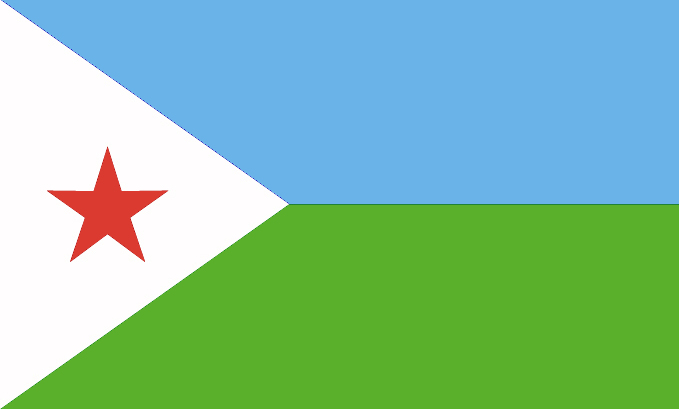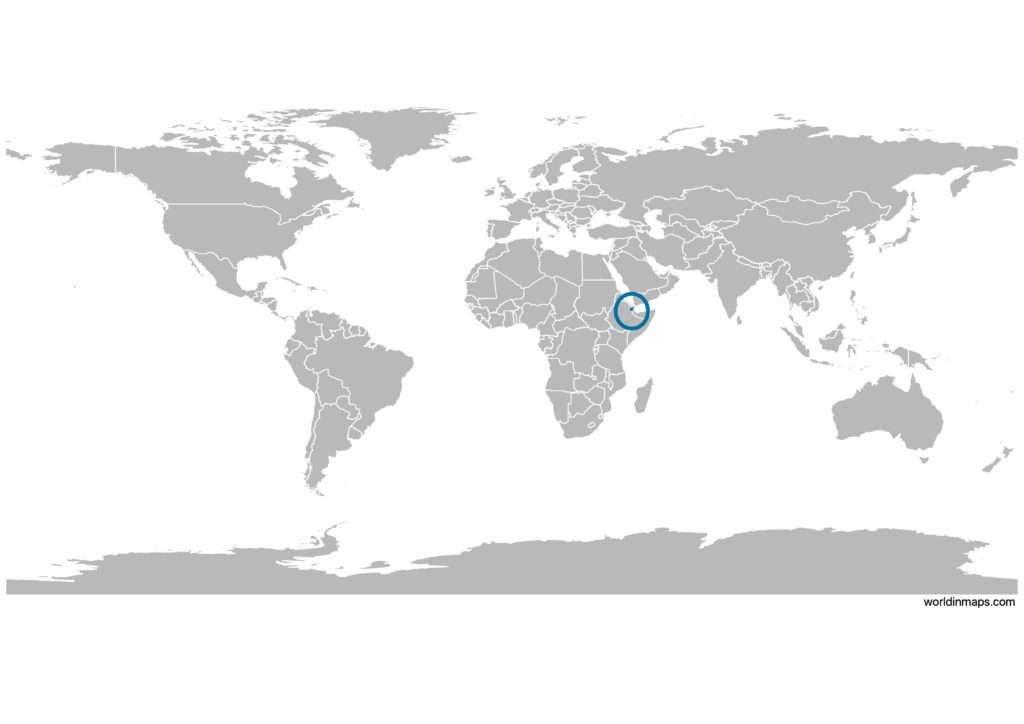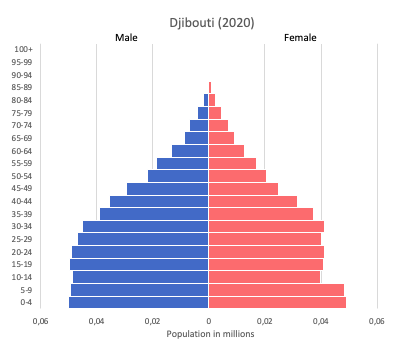Djibouti

| Government | |
| Name | Republic of Djibouti |
| French | République de Djibouti |
| Arabic | جمهورية جيبوتي Jumhūrīyah Jībūtī |
| Somali | Jamhuuriyadda Jabuuti |
| Afar | Gabuutih Ummuuno |
| Government type | Presidential republic |
| Capital | Djibouti 475,322 (2009)) |
| Currency | Djiboutian franc (DJF) |
| People | |
| Population (2020) | 988,002 (160th) |
| Density of population | 37.2 P/km2 (168th) |
| Nationality | Djiboutian |
| Official languages | |
| French | |
| Arabic | |
| Ethnic groups | |
| Somali | 60% |
| Afar | 35% |
| Other (mainly Yemeni Arab, French,Ethiopian and Italian) | 5% |
| Religions | |
| Sunni Muslim | 94% (nearly all Djiboutians)% |
| Christian | 6% (mainly foreign-born residents) |
| Life expectancy (2020) | |
| Male | 62.1 years |
| Female | 67.4 years |
| Total population | 64.7 years (199th) |
| Homicides | |
| n.a. | |
| Geography | |
| Land area | 23,180 km2 |
| water area | 20 km2 |
| total area | 23,200 km2 (151st) |
| Mean elevation | 430 m |
| Lowest point | |
| Lac Assal | -155 m |
| Highest point | |
| Moussa Ali | 2,021 m |
| Land use (2011) | |
| Agricultural land | 73.4% |
| Arable land | 0.1% |
| Permanent crops | 0% |
| Permanent pasture | 73.3% |
| Forest | 0.2% |
| Other | 26.4% |
| Urbanization | |
| Urban population (2020) | 78.1% |
| Rate of urbanization | 1.67% annual rate of change (2015 – 2020) |
| Economy | |
| Labor force (2012) | 294,600 (163rd) |
| Labor force by occupation | |
| Agriculture | NA |
| Industry | NA |
| Services | NA |
| Unemployment rate (2017) | 40% (213rd) |
| GDP (PPP) (estimate 2018) | |
| Total | $3.974 billion |
| Per capita | $3,788 |
| GDP (nominal) (estimate 2018) | |
| Total | $2.187 billion |
| Per capita | $2,084 |
| GDP by sector (estimate 2017) | |
| Agriculture | 2.4% |
| Industry | 17.3% |
| Services | 80.2% |
| Exports (2016) | $139.9 million (192nd) |
| Exports partners (2017) | |
| Ethiopia | 38.8% |
| Somalia | 17.1% |
| Qatar | 9.1% |
| Brazil | 8.9% |
| Yemen | 4.9% |
| US | 4.6% |
| Imports (2017) | $726.4 million (192nd) |
| Imports partners (2017) | |
| UAE | 25% |
| France | 15.2% |
| Saudi Arabia | 11% |
| China | 9.6% |
| Ethiopia | 6.8% |
| Yemen | 4.6% |
Djibouti on the world map

Djibouti is located in Africa in the Horn of Africa.
Djibouti top 10 largest cities (2009)
- Djibouti (475,322)
- Ali Sabieh (37,939)
- Dikhil (24,886)
- Tadjoura (14,820)
- Arta (13,260)
- Obock (11,706)
- Ali Adde (3,500)
- Holhol (3,000)
- Airolaf (1,023)
- Randa (1,023)
Demography
Population pyramid

Age structure data
Estimate for 2020:
- 0-14 years: 29.97% (male 138,701/female 137,588)
- 15-24 years: 20.32% (male 88,399/female 98,955)
- 25-54 years: 40.73% (male 156,016/female 219,406)
- 55-64 years: 5.01% (male 19,868/female 26,307)
- 65 years and over: 3.97% (male 16,245/female 20,319)
Remark: the age structure of a population affects a nation’s key socioeconomic issues. Countries with young populations (high percentage under age 15) need to invest more in schools, while countries with older populations (high percentage ages 65 and over) need to invest more in the health sector. The age structure can also be used to help predict potential political issues. For example, the rapid growth of a young adult population unable to find employment can lead to unrest.
Population from 1950 to 2020
Source: United Nations, Department of Economic and Social Affairs, Population Division (2019). World Population Prospects 2019, Online Edition. Rev. 1.
Evolution of the life expectancy from 1960 to 2018
Source: World Development Indicators, The World Bank
Economy
Agriculture:
fruits, vegetables, goats, sheep, camels, animal hides
Industries:
construction, agricultural processing, shipping
Exports – commodities:
reexports, hides and skins, scrap metal
Imports – commodities:
foods, beverages, transport equipment, chemicals, petroleum products, clothing
Time zone and current time in Djibouti
Go to our interactive map to get the current time in Djibouti